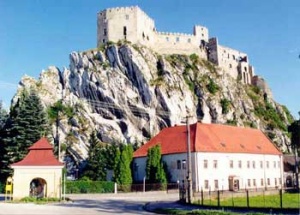Beckov/en: Unterschied zwischen den Versionen
K (Die Seite wurde neu angelegt: == History == thumb|300px|Castle Beckov The first written notice about the castle is from 1208 (the time period of the Great Moravian Empire). The c...) |
K (→Weblinks) |
||
| Zeile 15: | Zeile 15: | ||
== Weblinks == | == Weblinks == | ||
*Official homepage: http://www.bludni.sk/ | *Official homepage: http://www.bludni.sk/ | ||
| − | |||
| − | |||
| − | |||
| − | |||
Version vom 15. August 2007, 23:02 Uhr
History
The first written notice about the castle is from 1208 (the time period of the Great Moravian Empire). The castle basement is from 10-th century. Originally, Beckov was a royal castle, as mentioned for the first time in the document by Belo IV in 1255. Till 1379, Beckov remained a royal castle, except the period of time of about twenty years when Matúš Čák of Trenčín got possession of the castle and the domain belonging to it. After his death, royal wardens of a castle, appointed by the ruler, controlled the castle.
About ten years later, the ruler Zigismund gave the Beckov Castle with the domain to Ctibor, a magnate of a Polish origin. Ctibor changed the Beckov Castle into a palatial residence worth of the name of the most powerful Hungarian oligarch in those times. The castle experienced the period of time of its top prosperity. Ctibor invited several builders, masons and painters from the Venice region. They reconstructed the castle complex in the Renaissance style preserving many of original Gothic elements.
The Beckov Castle belonged to the first objects, which document beginnings of the Renaissance architecture in the Slovak history. Ctibor (who died 67 years old) had two children, a son Ctibor and a daughter Jachma. Ctibor Junior had only one daughter Katarína Margita. The last male descendant of the Bánffy family Ján, married to Margita Forgáč, who owned the castle, died childless and relatively young in the war against Turks in 1595.
The families of Esterházy (for example Imre Esterházy (1663-1745), Kaniszai, Nádasdy, Druget, Pongraz, Sunog and Ratkay shared the ownership of the Beckov Castle. Some co-possessors who found the Beckov Castle uncomfortable and not luxurious enough to live in but mostly because they did not want to finance its maintenance and repairs left it and had palatial mansion and manor houses built in the town.
The Beckov Castle started to fall into ruins as early as in 17-th century. The condition of the castle got also worse because of presence of imperial military garrison, which stayed here in the time of anti-Habsburg riots. The large fire, which broke out in the town in 1709, became fatal to the castle. Strong wind also blew sparks to the castle and set wooden structures into fire. The castle, deserted since that time, became more and more desolated and it turned into a ruin step by step.
Recently, the walls were partially conserved and some of the rooms were roofed to make the castle accessible for visitors and preserve at least something of the rich history for future generations.
Weblinks
- Official homepage: http://www.bludni.sk/
